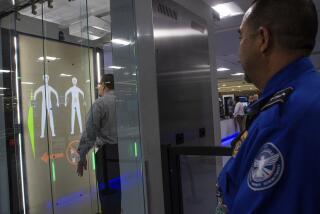Air Security Chief Details Plan to Check Travelers for Bombs
- Share via
WASHINGTON — Responding to criticism from the Sept. 11 commission, the government’s aviation security chief outlined a plan Wednesday to gradually begin screening airline passengers for bombs hidden under clothing.
But a senior lawmaker said the Bush administration was moving too slowly to close a widely acknowledged loophole: Although bags and shoes are checked for traces of explosives, people are not.
A suicide bomber wearing a device that contained small amounts of metal -- or carrying disassembled parts of a bomb -- could get past security.
“It’s a very real threat,” commissioner John F. Lehman said during a House subcommittee session on the commission’s airport security recommendations.
“It is only a matter of time,” said Rep. Peter A. DeFazio of Oregon, the top Democrat on the House Transportation and Infrastructure subcommittee on aviation, which held the hearing.
“A plastic explosive is not going to be detected with a [metal detection] wand,” DeFazio added. “If someone is wearing a belt [of explosives], it is not going to be detected.”
Transportation Security Administration chief David M. Stone testified that the agency had conducted an assessment of the risk and was taking steps to counter it.
“Our strategic view is that we are going to go ahead and develop a plan to address this issue at the [security] checkpoints,” Stone said.
For example, carry-on articles, shoes and documents of some travelers pulled aside for closer scrutiny are being tested more methodically for traces of explosives, he said.
And the agency is expanding a program to test and evaluate walk-through explosives detectors at select airports. The machines, which cost $132,000 apiece, test the air around a person for microscopic traces of explosives.
Four are now in operation, including one at Lindbergh Field in San Diego, with one more scheduled to begin its test in the coming weeks; 10 will be added next year. Each airport is testing the explosives-detection equipment for 30 to 45 days, the agency said.
Some of the other technology being evaluated has prompted concerns about intrusiveness. One X-ray-based machine can peer through clothing to reveal hidden explosives or weapons -- and an outline of the passenger’s body. Stone said the privacy concerns could be resolved by depicting only a stick figure on the display viewed by the machine’s operator, along with a general indication of where a suspicious item might be hidden.
DeFazio dismissed the agency’s explosive-detection plan as too cautious.
He said it fell short of a recommendation by the Sept. 11 commission that the government should begin checking for explosives on every passenger pulled aside for special screening.
Pat-down searches might work until the right technology could be deployed, DeFazio said.
Lehman also said the steps outlined by Stone did not satisfy the recommendation, but that he did not want to pass judgment on the agency’s overall effort.
Separately, Stone said he would move soon to comply with another commission recommendation -- that the government take over from the airlines the job of checking passengers against various security watch lists.
The commission found the current system flawed because intelligence agencies did not give airlines some highly classified information on terrorism suspects.
The present system has also created embarrassment for the government by picking out innocent passengers whose names are similar to those on the security lists.
Last week, Sen. Edward M. Kennedy (D-Mass.), one of the most recognizable figures in American public life, said that he had been confused with another Kennedy on the list.
Under the new system, airlines will transmit their reservation lists to the government for screening against watch lists. Stone promised more effective procedures for clearing up cases of mistaken identity.
Also on Wednesday, the government announced the award of two $45-million contracts to develop prototypes of a missile defense system for airliners. BAE Systems and Northrop Grumman Corp. won the bids.
Although there is no credible specific intelligence about planned missile attacks against U.S. airliners, the Department of Homeland Security is developing countermeasures at the urging of Congress.
More to Read
Sign up for Essential California
The most important California stories and recommendations in your inbox every morning.
You may occasionally receive promotional content from the Los Angeles Times.













